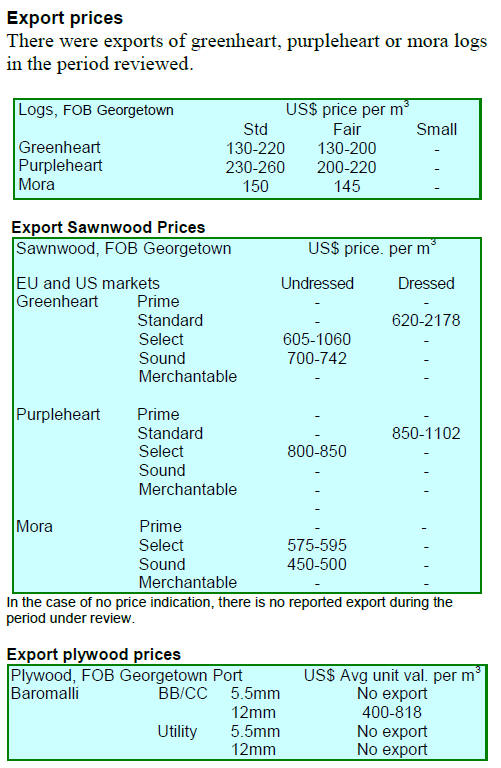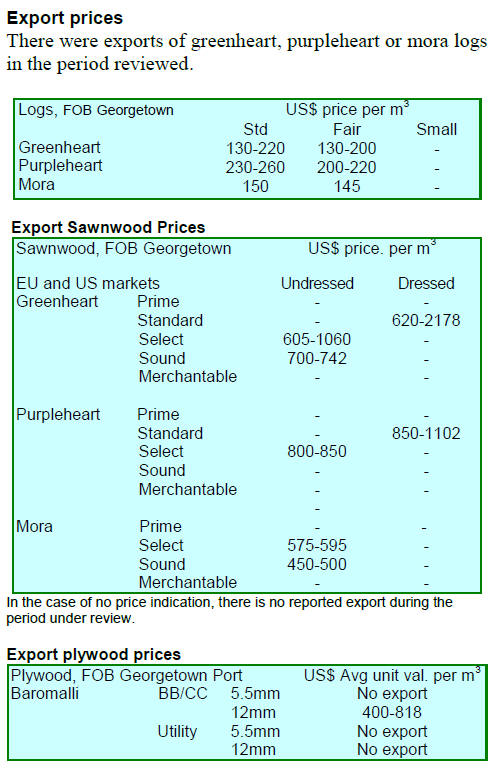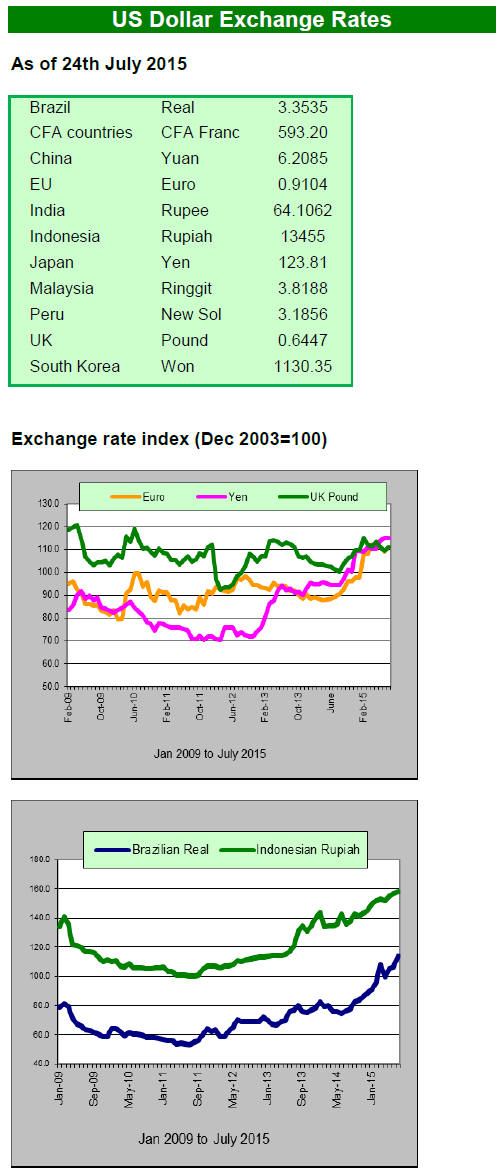2. GHANA
Exports register healthy increase
The volume and value of Ghana&s wood product exports
for the first five months of 2015 were up on the same
period in 2014.
According to the data released from the Research and
Statistical unit of the Timber Industry Development
Division (TIDD) of the Forestry Commission exports for
the first five months of 2015 totalled 141,744 cubic metres
worth around euro 72.74 million compared to the
114,161cubic meters and euro 46.77 million in 2014.
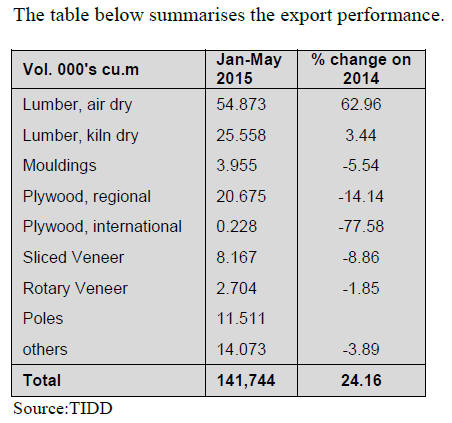
India a major buyer
Of the total exports for the period, primary products
accounted for 23,976 cu.m, secondary products 113,679
cu.m and tertiary products 4,089 cu.m. The leading
products in each category were billets (12,464 cu.m), airdry
sawnwood (53,975 cu.m) and mouldings (3.955cu.m.)
Markets in Asia imported 83,797 cu.m of Ghana&s wood
products, mainly poles and billets destined for India,
followed by African regional markets (20%) and Europe
(13%).
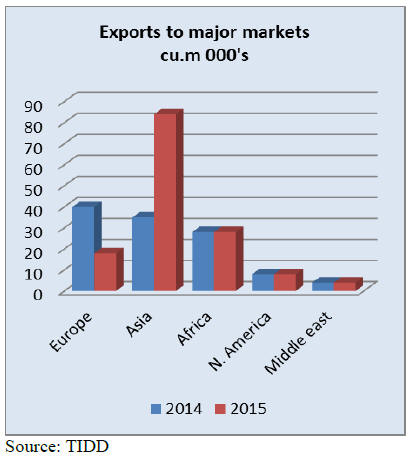
Fuel prices fall but job cuts loom
The steady appreciation of the cedi is having a welcome
knock-on effect on fuel prices.
This has come as a huge relief to manufacturers, most of
which had to utilise generators to keep plants operating. If
fuel prices can be held at current levels consumers will
eventually benefit from reduced prices.
However, there are risks ahead. In a mid-year review and
presentation of a supplementary budget to parliament the
Minister of Finance, Mr. Seth Terkper, announced a
revised forecast for GDP growth from 3.9% to 3.5% and
he anticipates year-end inflation to worsened from 11.5%
to 13.7%.
In a statement to the press after the review by the minister
a spokesperson from the Association of Ghana Industries
warned job losses are likely to rise as a result of the
downward review of the GDP projections.
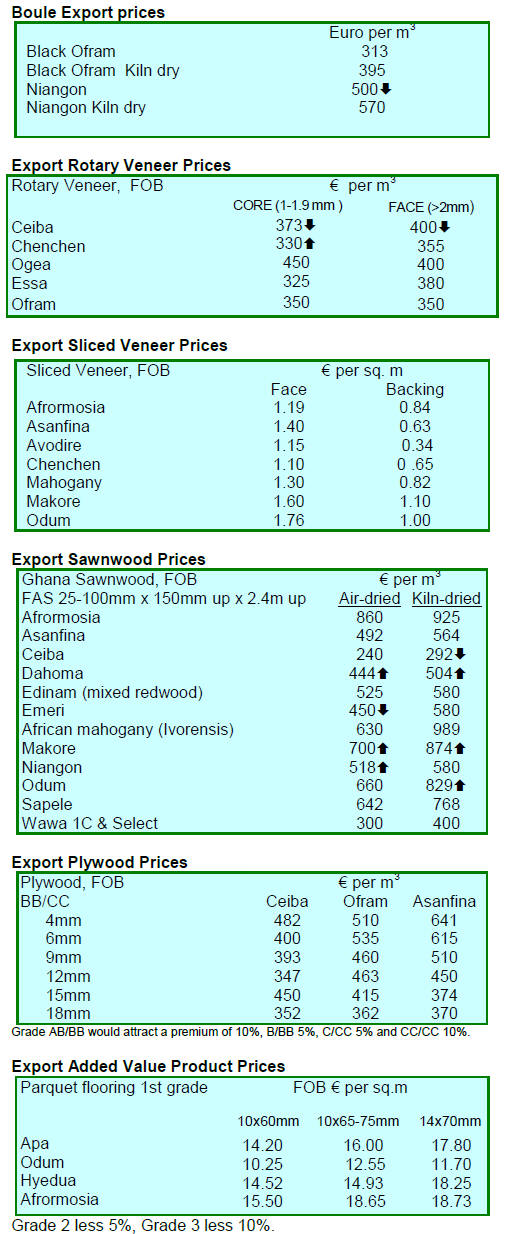
﹛
3. MALAYSIA
Companies told 每 „Get serious about
certification‟
Certified sustainable forest management was the centre
piece of a recent workshop in Sarawak 求Market
requirements for timber and timber product legality
affecting Sarawak: forging the path forward′.
This two day workshop was organised by the Sarawak
Forestry Department, WWF Malaysia and NEPCon
(Nature, Ecology and People Consult).
State Forest Department Director, Sapuan Ahmad, told
timber licensees in Sarawak that they must achieve the
target of being certified for sustainable forest management
by 2017.
Licensees were advised that they could choose the
Malaysian Timber Certification Council (MTCC) or any
other internationally recognised certification scheme.
Sapuan also urged timber companies in the State to
eliminate illegal timber from the domestic supply chain.
50% of forests in Sabah classified as permanent
reserves
The fourth "Fact Sheet on Forest Reserves in Sabah" has
been published by the Sabah Forestry Department. This
provides information on the forest reserves in the State as
well as news on areas gazetted, reclassified or removed.
In a press release, Sabah Forestry Director, Sam Mannan,
said about 3.6 million hectares or 49 per cent of the total
Sabah land mass has been gazetted as Permanent Forest
Reserves bringing them under the jurisdiction of the Sabah
Forestry Department.
Permanent Forest Reserves in Sabah are classified into
seven classes based on their specific functions to serve
both economic and environmental purposes.
Ringgit at 16 year low
The Malaysian ringgit has come under considerable
pressure over the past 12 months. The fall in oil prices, the
likelihood of an interest rate rise in the US and concerns
on the finances of a Malaysian state investment company
have all influenced the ringgit/dollar exchange rate.
So far this year the ringgit has fallen around 8% against
the dollar and in mid-July fell to its lowest in 16 years.
4. INDONESIA
Economic case for conservation of
Indonesia‟s forests
A 求Forest Ecosystem Valuation Study′ for Indonesia has
been released by the United Nations Office for REDD+
Coordination in Indonesia (UNORCID).
This is a critical step in capturing, demonstrating and
recognising the multiple benefits provided by forest
related ecosystem services for Indonesia&s economy and
for the livelihoods of the rural poor.
The study demonstrates how timber, which acts as a
critical provisioning service, adds more than US$14
billion to the Indonesian economy. Not only would a
further degradation of forest areas contribute to a decrease
in this crucial source of revenue, but would also result in a
significant loss in tax revenues.
The study emphasises the urgent need for the government
to find alternative ways of conserving forests and
simultaneously protecting the livelihoods of people
dependent on forest services. One of the ways of
achieving this is through community management of forest
resources.
The study emphaises that at the national and provincial
level forestry remains a key sector in terms of employment
in remote areas, but also in its important contribution to
other branches of the economy.
The report can be found at:
http://www.unorcid.org/upload/FEVS_Indonesia_Reportfinal.
pdf
Boost to domestic demand for furniture and crafts
Domestic sales of furniture and craft items traditionally
rise in the holiday period after Ramadan and this year
sales were up around 12% on Eid Mubarak according to
Abdul Sobur, Secretary General of the Association of
Indonesian Furniture and Handicraft (AMKRI).
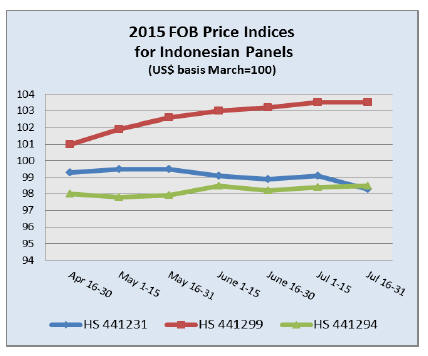
5. MYANMAR
Export earnings from the forestry sector
A rise in export earnings from the forestry sector has been
reported. The value of export shipments between April and
July were worth US$48 million of which US$2 million
was earned by state enterprises.
The value of 2015 exports was better than the US$12
million in the same period in 2014. According to the
Ministry of Commerce, Myanmar earned US$94 million
from timber product exports in fiscal 2014-15.
Life sentences for timber smugglers
A court in Myitkyina, the capital of Kachin State has
concluded the case against a group of Chinese charged
with being in Myanmar illegally and of smuggling timber
out of the country.
The defendants were charged under immigration laws and
also under Ah-pa-ka 3 (Protection of Public Property Law
No. 3) which carries a minimum 10 years in prison.
All defendants were found guilty and 153 were given life
sentences (20 years) and two others were jailed for ten
years. The harshness of the sentences has attracted
worldwide attention.
Just two weeks after the conclusion of the trial the
Myanmar government pardoned the prisoners and
arranged for their repatriation to China.
More on this story can be found at:
http://www.globaltimes.cn/content/933479.shtml
and
http://www.channelnewsasia.com/news/asiapacific/myan
mar-frees-chinese/2018204.html
Latest tender prices
The following timber was sold by Myanma Timber
Enterprise by tender on 24 July 2015. Log volumes are
expressed in hoppus tons (H.tons) and conversions and
sawn teak ( including hewn timber) are shown in cubic
tons (C.tons).
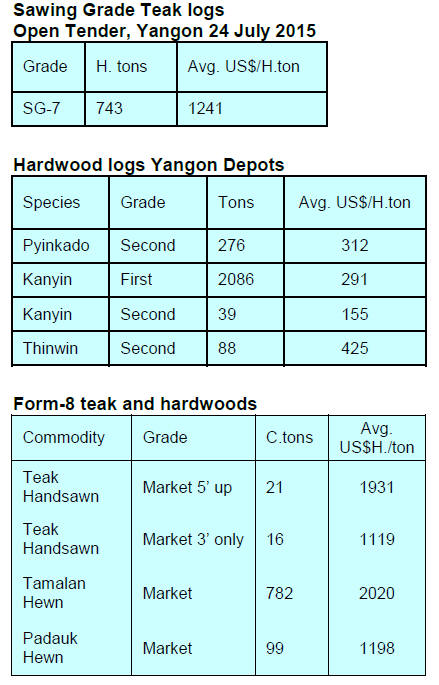
6.
INDIA
Inflation rate trends down
The Office of the Economic Adviser (OEA) to the Indian
government provides trends in the Wholesale Price Index
(WPI).
The official Wholesale Price Index for all commodities
(Base: 2004-05 = 100) for June rose by 0.5% to 178.6
from 177.7 in May. The year on year annual rate of
inflation, based on monthly WPI, stood at -2.4%
(provisional) for June 2015 compared to -2.36% for May.
For more see:
http://eaindustry.nic.in/cmonthly.pdf
Timber and plywood price indices climb
The OEA also reports Wholesale Price Indices for a
variety of wood products. The Wholesale Price Indices for
Wood products and Plywood are shown below.
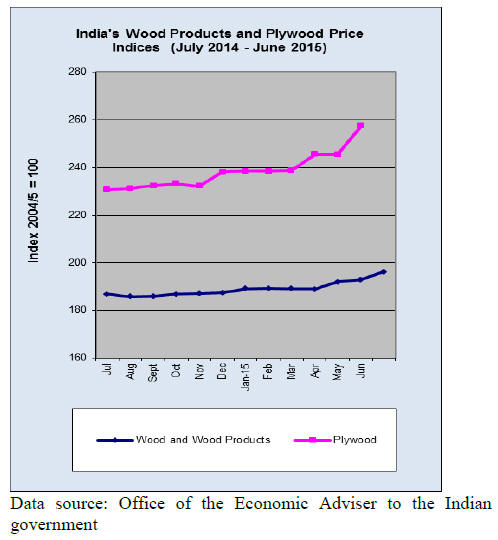
The June price indices for wood and wood products
and
plywood both show marked gains from a month earlier
reflecting increased demand as consumer confidence
strengthens.
See http://eaindustry.nic.in/display_data.asp
Removing constraints to farm timber plantations
There is a long tradition of growing commercial timber
trees on small farmers in India and such farm forests once
were a primary source of raw materials for many domestic
mills.
However, this practice has been declining over the past
few decades mainly because of unfavourable legislation
and overly complicated regulations relating to forestry and
agriculture but this is about to change.
Discussions are underway to unravel the various
regulations imposed by multiple agencies such as the State
Departments of Forestry, the Land Revenue Office and
other agencies which have imposed regulations on felling
and transport of logs. The sheer complexity of regulations
has discouraged the production of timber trees on farms.
A new policy will be developed to effect coordination of
the various administrations. It has been proposed that the
new policy would be implemented through a special
forestry mission or board.
In addition, discussion are on-going on ensuring security
of land tenure, promoting research and capacity building,
felicitating participation of industry and appropriate
incentives to farmers.
The new policy involves a major shift in outlook towards
farm forestry. Earlier, farm forestry was viewed as the
responsibility of the forestry administration but now the
policy views it through the prism of agriculture.
The acceptance that farm plantation timber is an agriproduct
will enable the Central Empowered Committee to
issue more licenses for wood based industries say analysts.
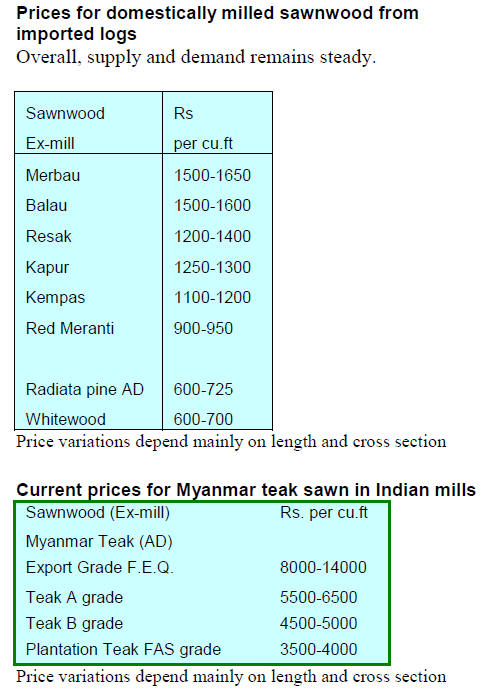

Plywood prices
Continuing weak demand in the housing sector is a major
concern for domestic plywood manufactures many of
which have cut output. Under present market conditions
millers find it impossible to raise prices to off-set their
increased production costs.
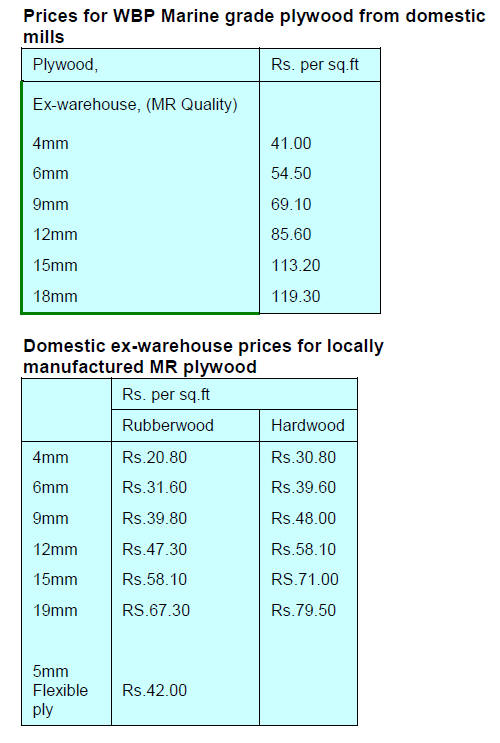
7.
BRAZIL
Market recovery and exchange rate boost
to exports
Recovery in the US housing market has benefited the
timber sector in Paran芍 State. Sawnwood exports grew
16.7% to US$64.9 million in the first half of 2015
compared to the same period last year. Plywood exports
from mills in the state also increased, growing by almost
19% to US$185.3 million in the same period.
According to the Federation of Industries of Paran芍 State
(FIEP), MDF and plywood are primarily used in the
construction and furniture industries in America.
As a result of the 2008 financial crisis demand in the US
for woodbased panels fell sharply. Prior to 2008 around
50% of exports from Paran芍 were destined for the US but
this fell to 15% during the crisis and while there has been
some improvement. Currently the US accounts for just
22% of wood product exports from Paran芍 State.
The Paran芍 Institute for Economic and Social
Development has forecast an improvement in exports in
the second half of this year which should offset the poor
performance in the first half.
Wood products prominent in exports
The main importers of Brazilian agri-products in June
2015 were China, the United States and the Netherlands.
In total, imports by these countries totaled US$4.35 billion
and accounted for almost 48% of exports. Among the
sectors that stand out in June include forest products, pulp,
paper and timber.
According to the Brazilian Agri-business External Trade
Statistics System (AGROSTAT), the main Chinese
imports were soy bean products (US$ .95 billion),
followed by forest products (US$144.9 million)
comprising pulp, paper and timber.
The main products imported by the United States in June
2015 were forest products, (US$ 215.7 million) of which
pulp accounted for US$ 99.7 million followed by timber at
US$92.2 million and paper at US$23.80 million.
The Netherlands is a major importer of Brazilian soy
products (US$255.2 million), followed by forest products
(US$88.8 million) most of which is pulp.
Amazon monitored by orbital radar
The Ministry of Defense has announced an investment of
R$ 80.5 million to combat illegal deforestation and other
forest crimes in the Amazon.
Through coordination by the Operations and Management
Center of the Amazonian Protection System (CENSIPAM)
in partnership with the Brazilian Institute for Environment
and Renewable Natural Resources (IBAMA) and the
National Institute for Space Research (INPE) an ´orbital
radar´ system will be deployed to monitor deforestation
in the Amazon. Information will be relayed to INPE to
feed into the Deforestation Detection System (DETER).
Export update
In June 2015, the total Brazilian exports of wood-based
products (except pulp and paper) increased 15.5% in value
compared to June 2014, from US$ 200.6 million to US$
231.7 million.
Pine sawnwood exports increased 73% in value in June
2015 compared to June 2014, from US$17.9 million to
US$30.9 million. In volume terms, exports increased 76%,
from 76,500 cu.m to 134,800 cu.m over the same period.
Tropical sawnwood exports fell 14%% from 30,600 cu.m
in June 2014 to 26,300 cu.m in June 2015. In terms of
value, exports fell from US$16.5 million to US$13.0
million over the same period.
On the other hand, pine plywood exports jumped 17% in
value in June 2015 in comparison with June 2014, from
US$29 million to US$34 million.
The volume shipped increased 29%, from 77,300 cu.m
to
99,600 cu.m, during the same period.
Tropical plywood exports, while small, more than
doubled from 4,400 cu.m in June 2014 to 9,800 cu.m in
June this year. The value of tropical plywood exports
increased 74%, from US$2.7 million in June 2014 to
US$4.7 million in June this year.
Wooden furniture exports in June were disappointing
rising to only US$ 35.2 million in June this year from
US$35.1 million in June 2014.

8. PERU
Peruvian furniture makers tour Brazil
Delegations of 20 furniture entrepreneurs from Peru
recently visited Brazil and were hosted by the Union of
Furniture Industries of Bento Goncalves.
The Peruvian visitors toured manufacturing companies in
the region and took advantage to observe technologies and
production processes being applied in furniture making.
Peru is a major market for Brazilian furniture exporters.
Surprisingly, domestically made furniture is not popular
with consumers in Peru who prefer imported furniture.
In 2014 Peru was the second largest market for furniture
exporters in Bento Goncalves but last year exports to Peru
fell 25% compared to a year earlier. However, in the first
quarter of this year Peru&s imports of furniture from Bento
Goncalves furniture producers expanded by over 50% year
on year.
Particleboard imports fall
Peru&s particleboards imports in the first half of this year
were down 11% to US$35.4 million compared to the
US$39.8 million in the same period in 2014.
Novopan Peru remained the largest particleboard importer
with a 39% share of imports worth around US$13.8
million but this was down around 17% year on year.
On the other hand Grupo Martin reported an expansion of
imports of particleboard to US$5.9 million compared with
US$ 3.8 million in the same period in 2014.


9.
GUYANA
First half export performance
Guyana&s wood product exports comprise logs,
sawnwood, roundwood and fuelwood, shingles and value
added products. In the first half of 2015 earnings from
wood product exports increased by just over 11% on the
same period in 2014 to US$21.7 million.
Log exports in the first half of 2015 generated earnings of
US$11.8 million compared to the US$8.7 million in the
first half of 2014.
First half 2015 sawnwood export earnings amounted to
US$9.4 million compared to US$8.8 in the same period in
2014, an increase of almost 7%.
However, plywood exports fell during the first half of this
year to US$0.91 million as against the US$0.97 million in
the first half of 2014, a decline of around 6%.
Exports of shingles were encouraging and earned
US$0.88
million in the first half of 2015 and exports of roundwood
and fuelwood fetched US$0.94 million in the first half of
this year. Guyana&s exports of added value products are
modest and first half 2015 earnings totaled just
US$130,000.
The majority of Guyana&s wood product exports are to
markets in Asia, the Caribbean, Europe, Oceania, Middle
East countries and North and South America.
